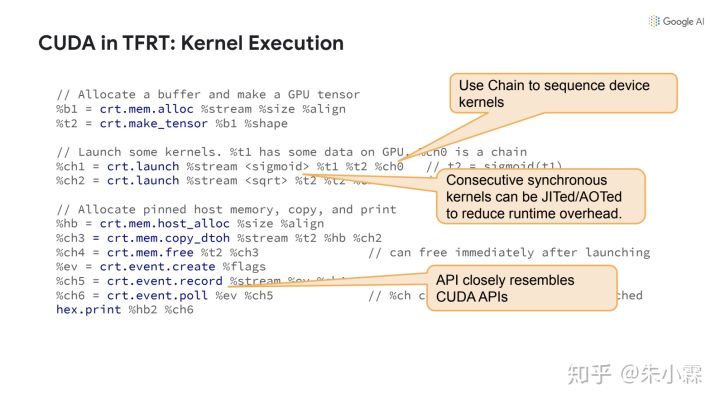淺析 TensorFlow Runtime 技術
阿新 • • 發佈:2020-12-25
# 關於 TF Runtime 的疑問?
## 什麼是TFRT ?
**TensorFlow Runtime**,簡稱 TFRT,它提供了統一的、可擴充套件的基礎架構層,可以極致地發揮CPU多執行緒效能,支援全非同步程式設計(無鎖佇列+非同步化語義)。TFRT 可以減少開發、驗證和部署企業級模型所需的時間。

## TFRT 的輸入是什麼?
輸入為Tensorflow GraphDef,TFRT 會呼叫**基於MLIR的圖編譯器**,執行圖優化,並將其lower成 BEF —— 用於執行TFRT graph的二進位制可執行格式。

+ 在TF原生框架中,執行的流程是:Python Layers → GradDef (DAG) → 執行OpNode (ThreadPool並行)
+ Runtime 的思路:Python Layers → GradDef (DAG) → Compile IR → Binary (BEF) → execute (`BEFExecutor`)
基礎概念:
+ `Host Program in MLIR`是graph的低階中間表示
+ `BEF`是一個`BEFExecutor`的可執行檔案,讀取`BEF`檔案,然後非同步執行裡面的函式
+ 兩者通過`tfrt_translate`來轉換,類似彙編器 Assembler
## 這裡的 IR 是什麼?
其實可以理解為是一套表示**拓撲關係**的程式碼,甚至是一個graph。通過拓撲遞推,可以很容易轉為一段IR程式碼。這也是為什麼BEF支援IR與Graph的互轉的原因。比如:
``` cpp
%1 = hex.constant.i32 1
%2 = hex.constant.i32 2
%3 = hex.add.i32 %1, %2
hex.print.i32 %3
# 實際可以表示為一個DAG圖
```
## 和 XLA 的區別?
XLA 本質上並沒有脫離**圖執行**的框架,它只是通過 graph cluster 把部分**子圖**通過 HLO 的轉換走 JIT 執行,將子圖包裹在一個`XlaRunOp`裡,再與圖的其他節點一起執行。所以只是把幾個節點換成了一個更快的大節點。(看起來有點類似fuse)
官方文件裡稱`BEF`為 Kernel graph的實際載體,實際還是一個graph,即表示bef executor最終執行的實體依然是一個 graph(但不是TF原生意義的GraphDef)。
## TFRT 基本執行單元是什麼?執行的流程?
TFRT裡的 kernel 概念,分為如下兩種:
+ 同步 Kernel
+ 完全在呼叫它的執行緒中執行,不會涉及到其他執行緒裡的計算。它產生的`AsyncValue`狀態都是available的
```cpp
int32_t TFRTAddI32(Argument arg0, Argument arg1) {
// The thread that calls TFRTAddI32 performs this addition, and produces
// an available AsyncValue.
return *arg0 + *arg1;
}
```
+ 非同步 Kernel
+ 包含兩個部分的計算:①呼叫它所線上程的同步計算 ② 其他執行緒中的非同步計算。它產生的`AsyncValue`狀態是unavailable的(並不全是)
```cpp
void TFRTAddI32Async(Argument arg0, Argument arg1,
Result output, HostContext* host) {
// Synchronously allocate an unavailable AsyncValue for ‘output’.
auto result = output.Allocate();
// Asynchronously make ‘output’ available.
host->EnqueueWork([arg0 = *arg0, arg1 = *arg1,
result_ref = FormRef(result)] {
// A ConcurrentWorkQueue thread performs this addition.
result_ref->emplace(arg0 + arg1);
});
// Synchronously returns unavailable ‘output’.
}
```
**執行流程:**
+ 建立一個AsyncKernelFrame,包含輸入引數和輸入result
+ 將Frame傳遞給kernel執行
+ 所有的AsyncValue通過registers來跟蹤
也提供了eager API (op-by-op):CoreRuntime 和 CoreRuntimeOp
+ CoreRuntime:
+ 執行OpHandler,藉助內部類Impl來實現
+ 它可以呼叫`MakeOp(op_name, op_handler)`來建立一個`CoreRuntimeOp`直接執行
+ CoreRuntimeOp
+ 持有一個`llvm::unique_function>`型別的函式指標`fn_`
+ 仿函式用於執行函式`fn_`
## 如何整合硬體裝置的?
藉助 DeviceRuntime,讓BEF只支援最底層的driver API的Op,從而儘量避免讓每一種後端都單獨實現一遍tf的各個Op。
如下圖中使用的op直接對應到了cuda api:

# Host Runtime的設計思路
## Host Runtime 的位置?

host 指執行計算的機器裝置,可能有,也可能沒有硬體加速的資源。host 可以只是一個具有多GPU的伺服器,或帶有DSP和IPU的移動裝置。
在TF原生的框架中,TF Core是按照 data-flow 進行op-by-op的執行,設計上有很多順序同步執行的影子在裡面。**而 Host Runtime 通過重新編排計算邏輯,然後驅動 Device Runtime(如GPU、TPU)去加速計算**,使得kernel的執行可以單獨放在一個執行緒中,去非同步執行,充分利用的多執行緒並行的優勢。

## 為什麼要做這件事?
+ 期望能高效的eagerly執行op
+ TF對graph執行已經優化的很好了,畢竟都在C++端執行。但在earge模式下,python和runtime端之間的不必要的開銷還是在存的。
+ 統一圖和op兩個不同層次下多執行緒並行機制
+ **runtime 中非同步是一等公民**
+ a non-strict kernel/function may execute before all its inputs are ready.
+ 更輕便地進行cross-kernel優化
+ TF 的op Kernel實現中封裝了 Tensor 的記憶體申請之類的邏輯,這限制了cross-kernel中reuse buffe的優化。在 TFRT的kernel中,解耦了 shape計算和 tensor 記憶體申請的邏輯
+ 實現模組化、可插拔式的新硬體支援機制
+ 期望解決之前為了接入新硬體而不得不hack整個程式碼庫的痛點;能夠建立一種模組化機制,直接提供完善的接入文件給硬體團隊即可,變被動為主動。
## 如何去設計來實現上述目標麼?
先回顧下背景: Core Runtime, Graph Lowering 和 Eager Execution
1. Core Runtime
用來 eagerly 執行單個 op 或者整個graph function——包含GradDef 和 HLO。一個op graph通常是裝置獨立的。
2. Graph Lowering
Compiler passes 將一個op graph 轉化為一個Kernel Graph,它是一個數據流計算的更低階表示,為**更快執行**而設計,因此不適合做編譯分析,但可以通過低階方言(如MLIR)來表示。Kernel graph是面向指定裝置的(與平臺繫結)
3. Eager Execution
Host Runtime支援eagerly 執行。但並不一定會涉及Graph/BEF的構造和BEFExecutor的使用。TF設計了兩個方案:
+ Generic path:把 op 當做graph function來處理,可以很好處理組合 op 的情況,也可以複用graph function的那一整套程式碼。
+ Fast path:使用手寫的C++或者預編譯的 graph snippets 去完成op kernel的選取和呼叫(定製化優化?成本不高麼?)
## Kernel Graph 中的 Kernel 指什麼?
TFRT裡面也有 kernel 的概念,輸入輸出均為:[`AsyncValue`](https://github.com/tensorflow/runtime/blob/master/documents/tfrt_host_runtime_design.md#asyncvalue)——**非同步是一等公民**的踐行者。類似C++標準庫中的 [future](https://en.cppreference.com/w/cpp/thread/future) 和 [promis](https://en.cppreference.com/w/cpp/thread/promise)的組合。 graph中的所有data全部都會替換為`AsyncValue`。
執行流程:
+ 建立一個AsyncKernelFrame,包含輸入引數和輸入result
+ 將Frame傳遞給kernel執行
+ 所有的AsyncValue通過registers來跟蹤
```cpp
// Kernel that adds two integers.
// AsyncKernelFrame holds the kernel’s arguments and results.
static void TFRTAdd(AsyncKernelFrame* frame) {
// Fetch the kernel’s 0th argument.
AsyncValue* arg1 = frame->GetArgAt(0);
// Fetch the kernel’s 1st argument.
AsyncValue* arg2 = frame->GetArgAt(1);
int v1 = arg1->get();
int v2 = arg2->get();
// Set the kernel’s 0th result.
frame->EmplaceResultAt(0, v1 + v2);
}
```
> TODO: Kernel中的[記憶體申請接入機制](https://github.com/tensorflow/runtime/blob/master/documents/tfrt_host_runtime_design.md#memory-allocation)
Kernel 型別分為如下兩種:
+ 同步 Kernel
+ 完全在呼叫它的執行緒中執行,不會涉及任何其他執行緒的計算。它產生的`AsyncValue`狀態都是available的
```cpp
int32_t TFRTAddI32(Argument arg0, Argument arg1) {
// The thread that calls TFRTAddI32 performs this addition, and produces
// an available AsyncValue.
return *arg0 + *arg1;
}
```
+ 非同步 Kernel
+ 包含兩個部分:①呼叫它所線上程的同步操作 ② 其他執行緒中的非同步操作。它產生的``AsyncValue`狀態是unavailable的(並不全是)
```cpp
void TFRTAddI32Async(Argument arg0, Argument arg1,
Result output, HostContext* host) {
// Synchronously allocate an unavailable AsyncValue for ‘output’.
auto result = output.Allocate();
// Asynchronously make ‘output’ available.
host->EnqueueWork([arg0 = *arg0, arg1 = *arg1,
result_ref = FormRef(result)] {
// A ConcurrentWorkQueue thread performs this addition.
result_ref->emplace(arg0 + arg1);
});
// Synchronously returns unavailable ‘output’.
}
```
Kernel 的兩種執行模式:
+ Strict mode:
+ 此類Kernel被呼叫時,所有的`AsyncValue`均已是available。
+ [non Strict mode](https://github.com/tensorflow/runtime/blob/master/documents/tfrt_host_runtime_design.md#non-strict-control-flow):
+ 只要有一個輸入引數是available,就執行。比如三元操作,它其實只負責轉發
```cpp
result = ternary(condition, true_result, false_result) //只要condition可用即可
```
+ 這類kernel實現難度較高
## `AsyncValue`有什麼用途?
前面提到:Kernel 的輸入輸出均為:[`AsyncValue`](https://github.com/tensorflow/runtime/blob/master/documents/tfrt_host_runtime_design.md#asyncvalue),graph中的所有data也全部替換為了`AsyncValue`。
```cpp
// A subset of interface functions in AsyncValue.
class AsyncValue {
public:
// Is the data available?
bool IsAvailable() const;
// Get the payload data as type T.
// Assumes the data is already available, so get() never blocks.
template const T& get() const;
// Store the payload data in-place.
template
void emplace(Args&&... args);
// Add a waiter callback that will run when the value becomes available.
void AndThen(std::function&& waiter);
// ...
};
```
**AyncValuea有三個派生類:**
+ `ConcreteAsyncValue`:用於表示和存放具體data
+ `ErrorAysncValue`:用於處理異常傳播和取消執行。BEFExecutor會監控每個Kernel執行返回的值,若果某個result值為此型別,則跳過所有依賴此值的下游op
+ `IndirectAsyncValue`:有些情況下,某個result的dataType還不知道呢,但為了實現非阻塞機制,先建立一個IndirectSyncValue,保證non-strick Kernel的執行。它其實並不持有資料,而是持有了一個指向另一個`AsyncValue`的指標。
**生命週期**:通過引用計數實現:
+ kernel會首先對results建立AyncValue(當dataType確定時)
+ 一個AsyncValue的所有權會從kernel移交給BEFExecutor
+ BEFExecutor將AsyncValue傳遞給所有使用它的下游 Op,並遞增引用計數
+ 每個下游Op Kernel完成計算後,遞減此AsyncValue的引用計數
## 管理`AyncValue`的`Register`具體做哪些工作?
`Register`其實是一個指向`AyncValue`的指標,它也只操作指標,因此不涉及資料的移動和copy。
**舉個栗子**:
```cpp
available_value = upstream()
downstream(available_value, unavailable_value)
```
downstream需要等到兩個引數都ready才會執行。當`unavailable_value`也available時,執行器從`register`載入資料,然後傳遞給downstream去執行
**`register`有三種狀態:**
+ **Empty**:初始狀態,不指向任何`AsyncValue`
+ **Unavailable**: 只用於非同步kernel。同步kernel不會產生此狀態。
+ **Available**: 最終狀態,且狀態不可逆。

## RunTime 如何實現非同步加速的?
在 TFRT 中,執行Kernel的執行緒,與排程其他已ready的kernel的執行緒,可能屬於同一個。TFRT 把後臺排程kernel任務放到了一個`ConcurrentWorkQueue`中來非同步執行。
**但反向需要梯度才能執行,如何處理反向op以及IO阻塞問題呢?**
TF採用了兩個獨立的執行緒池:
①專用執行緒池:存放長時非阻塞任務
+ 固定執行緒數,每個硬體一個執行緒,避免執行緒資源搶佔帶來的開銷。
②單獨執行緒池:存放阻塞任務(如IO)
+ 申請多一些執行緒數來處理IO任務
+ 為了避免死鎖,阻塞任務只能放在阻塞執行緒池裡執行
+ 要求Kernel的實現不能直接包含阻塞操作(例如?),更不能將部分阻塞操作放到非阻塞佇列裡。
## 圖執行——Graph Executation
圖執行時,host program 會把 graph 轉換為MLIR表示的 Kernel graph。此處會應用一些compiler passes 將裝置無關的 graph 轉化為面向特定硬體平臺的 kernel graph。
```cpp
func @sample_function() -> i32 {
%one = tfrt.constant.i32 1 // Make AsyncValue with value 1
%two = tfrt.constant.i32 2 // Make AsyncValue with value 2
%three = tfrt.add.i32 %one, %two // Make AsyncValue with value 3 (1+2)
tfrt.print.i32 %three // Print AsyncValue %three
tfrt.return %three : i32 // Return AsyncValue %three
}
```
**runtime 並不直接執行IR**,而是通過`mlir_to_bef`將其轉換為 `BEF`後再執行。通過 registers 跟蹤和記錄所有 `AsyncValue` 的狀態。
### 如何解決control dependency問題?
在原生的TF中是通過`tf.control_dependencies`來對兩個有順序要求的Kernel新增依賴。在TFRT中,是通過[`Chain`](https://github.com/tensorflow/runtime/blob/master/documents/explicit_dependency.md)來實現。一個`chain`也是一個`AsyncValue`——可以是kernel的引數,也可以是result,這樣的話,Chain要求consumer必須在producer之後,以此實現有序性。
```cpp
func @control_dep1() {
%a = dht.create_uninit_tensor.i32.2 [2 : i32, 2 : i32]
%chain1 = dht.fill_tensor.i32 %a, 41
%chain2 = dht.print_tensor.i32 %a, %chain1
}
```
### 如何處理控制流的情況,如if ?
TFRT支援在Kernel中呼叫`BEFExecutor`(這一點跟Paddle目前的控制流處理思路有點類似)
```cpp
void TFRTIf(AsyncKernelFrame* frame) {
const auto* true_fn = &frame->GetConstantAt(0);
const auto* false_fn = &frame->GetConstantAt(1);
// First arg is the condition.
ArrayRef args = frame->GetArguments();
AsyncValue* condition = args[0];
// Execute true_fn or false_fn depending on ‘condition’.
auto* fn = condition->get() ? true_fn : false_fn;
fn->Execute(args.drop_front(),
frame->GetResults(),
frame->GetHostContext());
}
```
### 與底層的session的區別和聯絡?
貌似沒啥關係。(待深入瞭解)
## BEF檔案裡都包含了什麼資訊?
[BEF](https://github.com/tensorflow/runtime/blob/master/documents/binary_executable_format.md) 是runtime和compiler的橋樑,同時將compiler從runtime中解耦,從而可以獨立應用編譯優化策略。它支援儲存到磁碟,重新載入執行(mmap bytes)。感覺和二進位制檔案很類似,因為它也包括很多section的概念。
BEF 包含了一些與硬體裝置相關的資訊:每個Kernel在哪種裝置(CPU/GPU/TPU)上執行,以及哪些特殊的Kernel會被呼叫。
**MLIR和BEF之間可以互相轉換:**

## BEFExecutor的作用是什麼?有特殊效能收益嗎?
**它是一個執行器,而非一個直譯器**,因為它沒有**program counter**d的概念。
效能收益來源:
+ 它是 lock-free 的
+ 非阻塞執行:
+ 無論一個Value是否available,它都會執行下去。對於unvailable的value,執行器會將其推遲到`AsyncValue::AndThen`
+ 由於`AyncValue`都會由`Register`來跟蹤,它一旦ready,會通知和喚起所有相關kernel
# 遺留問題
## TFRT中公佈的文件中很少涉及訓練和反向op的內容,是否支援?
在官網給出的 [mnist_training.md](https://github.com/tensorflow/runtime/blob/master/documents/mnist_training.md)介紹中,提到了TFRT對訓練的支援,但只是原型展示,並非最終版本。
+ 單獨重寫了MNIST模型中所有的op,如matmul、relu、elem_add、argmax、reduce_mean
+ 這裡只重寫relu_grad的kernel,其他op的反向kernel預設使用的是Tensorflow框架的?
# 參考資料
1. [【官方文件】—TFRT Host Runtime Design](https://github.com/tensorflow/runtime/blob/master/documents/tfrt_host_runtime_des
